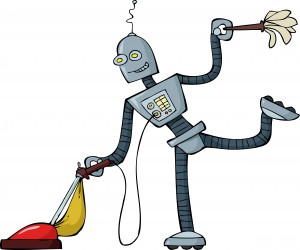Relearning Jidoka From a Robot Vacuum Cleaner
About 20 years ago, when I first trained on the Toyota Production System, it was presented to me that the second pillar of the Toyota production system was “Jidoka”. Jidoka is a Japanese word that means “automation with a human touch”. As I learned later, this definition just does not convey the quality concepts embodied in Jidoka. I admit, I had difficulty learning the Jidoka pillar because I got stuck on the word automation. I thought it was a call to automate processes with numerical control.
My Japanese Sensei explained that American Lean practitioners use the word “autonomation” instead. Hmm … sorry … not getting it. Still sounds like automating something to me. Later, during a plant tour, the Sensei pulled our group aside to show us a u-shaped manufacturing cell with 12 machines being operated simultaneously by a single operator. The operator’s job was to unload and reload a machine, press the start button, carry the processed part to the next machine, unload that machine and load the part from the previous machine, press start … and so on, for the entire circuit. Ah hah! The light bulb came on! Autonomation means achieving autonomous operation of a machine; getting it to run autonomously and make good parts, without the necessity for a human to stand there and watch it.
Back to the present. Last fall my wife and I saw numerous TV commercials promoting a robot vacuum cleaner. My wife thought it would be neat if it really worked. I remembered this at Christmas time and decided to surprise her with the thing she had commented on months earlier. She was indeed surprised, but not the way I expected. She immediately asked if I had problems with the way she cleaned the house!? (Key learning point: Don’t give your wife a vacuum cleaner as an unexpected gift.)  Once I got through that minefield, I skimmed the instructions and we picked the first room to clean. I positioned the electronic boundary beacon in the doorway, plugged in the base station, set the robot, pressed start and let it go. Fascinating! The robot started off in a random pattern throughout the room. When it bumped into something it stopped and turned in another direction. It remembered the walls and furniture it encountered and explored their boundaries. It was a big hit. My wife thought it was cute and fun to watch! Having redeemed myself, I left her to enjoy her gift.
Once I got through that minefield, I skimmed the instructions and we picked the first room to clean. I positioned the electronic boundary beacon in the doorway, plugged in the base station, set the robot, pressed start and let it go. Fascinating! The robot started off in a random pattern throughout the room. When it bumped into something it stopped and turned in another direction. It remembered the walls and furniture it encountered and explored their boundaries. It was a big hit. My wife thought it was cute and fun to watch! Having redeemed myself, I left her to enjoy her gift.
Twenty minutes later I checked on the robot and found my wife still watching. “So what do you think?” I asked.
She replied, “Well it saves me physical work but it does not save me time. I can do it faster myself. I could be done and on the way to the store by now.”
“What’s stopping you from going to the store?”
“I have to watch it.”
“I can see you are fascinated by it, but why don’t you let the robot do its work and go do something else?”
“It might do something wrong. It could get stuck, fall down the stairs, or make marks on the furniture. It might miss some spots.”
“Have any of these things happened so far?”
“Well, no. When it went into the corner and bumped the walls it rotated until it found a path out. Same thing around the furniture.“
“How about the stairs?”
“It started to go past the edge, then stopped and backed up.”
“OK, so it detected the ledge and responded to prevent it from falling down the stairs. Hmm… I wonder what would happen if it got stuck under the couch or got in a tight spot?”
We positioned a chair over the vacuum so that it was penned in. After a few attempts to free itself, the robot stopped. It beeped a few times and a recorded voice said “error, error”. I removed the chair, pushed the blinking start button and it started vacuuming where it left off. A few minutes later, it drove onto the base station, beeped to signal it had completed the room and turned itself off. I could tell from observing the wheel patterns in the carpet the vacuuming job was complete and no sections were missed (visual management).
This suddenly felt familiar. “You know,” I said, “the vacuum cleaner is a machine designed to do a process that humans do. To be effective it must be able to detect exceptions and respond, so they don’t become problems or continue as work defects.” I continued, “For the vacuum cleaner, the response may be a countermeasure such as turning or backing up, or shutting down and signaling that human intervention is required to resolve a problem.” In essence the machine has been equipped to sense problems and make some human-like judgments (automation with a human touch). It has sensors to detect when it runs into something or may run off the floor, and they tell the computer processor a response is required (detect abnormalities). We saw the machine making these adjustments and we tested it for its response to a problem (stop the line for quality problems).
I asked my wife if she thought she could trust the robot to do the job properly without damaging anything. I forged ahead saying, “If you can, then you don’t need to watch it run. The human work has been separated from the machines work. Your job is reduced to plugging in the base station, pressing the start button and walking away.”
Her response was a somewhat cool, “Uh-huh …”
Sensing I was once again nearing the minefield, I quickly said, “How about you plug the base station in the den, press the start button and I’ll take you out to dinner while it works.”
Here is our glossary definition for: Jidoka






